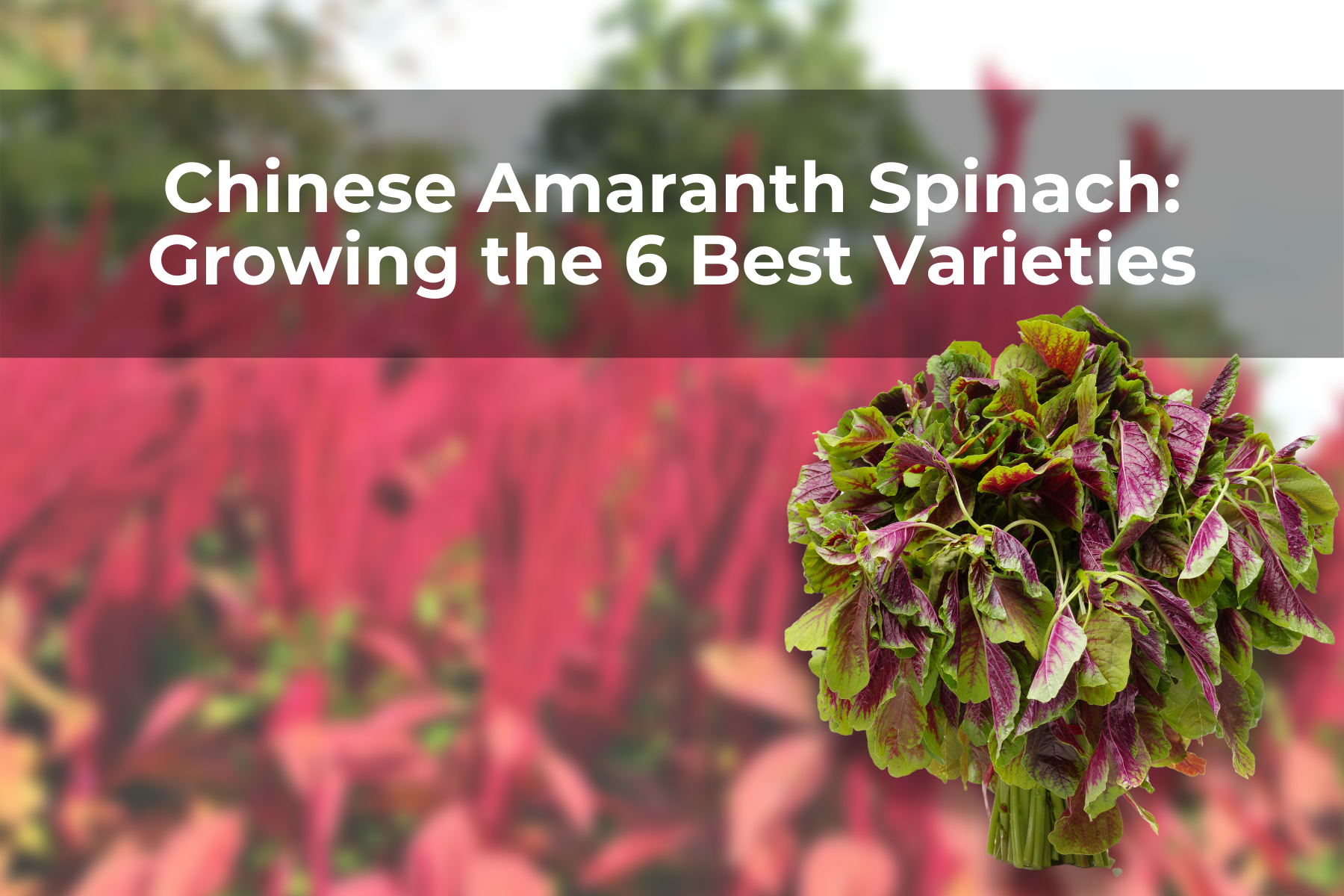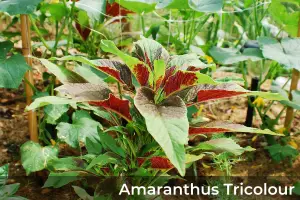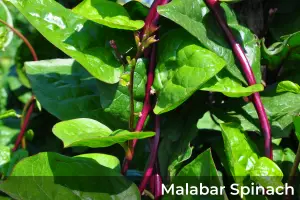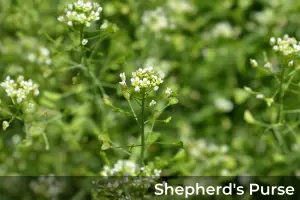Last Updated on April 11, 2024 by Real Men Sow
Chinese Amaranth spinach is a leafy green vegetable popular in many Asian cuisines. It is also known as Chinese spinach, yin Choy, or kankun. Amaranth spinach has a slightly sweet flavour and is often used in stir fry dishes. The leaves are a deep green colour, and the plant grows to about two feet. The amaranth spinach plant is native to Asia and has been cultivated for centuries.
1. Chinese Spinach (Amaranthus dubius)
Amaranthus Dubius (red spinach), is a leafy vegetable with a similar taste to spinach. Others call it yin-choy, hon–toi-moi or yin-tsoi. There are two main Chinese spinach varieties. One has plain green leaves, and the other has pink or purple highlights. Variegated spinach has a more robust flavour and a more incredible sweetness than regular spinach.
Chinese spinach is a staple food in Asian grocery stores and Asian markets. However, growing your own is best to ensure a consistent supply of delicious greens.
Growing Chinese Amaranth Spinach from seeds
It is easy to grow Chinese spinach from seeds. You can plant it anywhere from late spring through early autumn. To germinate the seeds, they need to be warm enough. If you are sowing outside, ensure it is not below 70°F (21°C).
Place the seeds in a sunny garden area in nutrient-rich, well-draining soil with a pH range from 6.5 to 8. Place the seeds about 3 inches apart (8 cm), water generously and keep the soil moist. It should take approximately 2 weeks for the seeds to sprout.
Although spinach does not require light to germinate but they do need at least 6 hours of sunlight per day, once they appear, ensure that they have at least 6 hours of sunshine each day.
This plant is fast growing and can be harvested within 30 days of sowing. Chinese Amaranth leafy greens can reach up to 3 feet (90cm) in height. You can also harvest young leaves using the cut-and come-again method while the main plant produces new leaves.
Uses
You can use Chinese spinach in the same way that regular spinach. It has a mild taste and is high in iron, calcium and potassium. You may eat young raw. Older leaves are the ones for curries with garlic and bhaji fritters.
2. Water Spinach (Ipomoea Aquatica)
Water spinach is a semi-aquatic, trailing plant that is native to India, Southeast Asia, and parts of Australia. In the Philippines and Indonesia, they call them kangkong or ong choy (Cantonese). Other common names include river spinach, Chinese watercress, swamp cabbage, and even Chinese watercress.
Water spinach is not a kind of spinach, contrary to its name. It is part of the same family as morning glory and even produces the same type of showy white flowers. It has long, arrow-shaped stems and leaves.
Growing Water Spinach from seeds
Water spinach is a semi-aquatic, tropical plant that can be grown in your garden. Soak the seeds for at least 24 hours before sowing to encourage germination. Water spinach doesn’t care about the type of soil and can tolerate pH levels from 5.5 to 7.0. It does require plenty of sunlight and warmth.
Place your water spinach seeds six inches (15 cm) apart, and then water well. These plants require a lot more water than other vegetables in your garden so don’t overwater them. You can grow them in hydroponic systems, especially in greenhouses, if you have the right setup.
Water spinach can grow to as tall as 12 inches (30cm), and its trailing stems can reach a maximum length of 10 feet (3 meters). It can be harvested in 60 days, but you may want to harvest it sooner if you prefer the stems and leaves when they are more tender.
Uses
Water spinach is rich in antioxidants, carotene and iron. It’s also healthy and delicious. Both the stems and leaves are edible. The leaves have a mild flavour similar to watercress but without the oxalic tang of regular spinach.
The stems are crisp and have a noticeable bitterness. Water spinach is often used in stir-fries with garlic, shrimp paste, curries and spicy fish soups.
3. Edible Chinese Amaranth (Amaranthus Tricolor)
Edible amaranth are for ornamental or culinary purposes. It is popular for ornamental landscaping and gardening due to its stunning red, green, and yellow leaves. This plant’s leaves and seeds are edible, and are used often in Asian and African cuisine.
Amaranthus tricolor grows quickly and often self-sows. This information will help you decide if you want to plant it in your garden to add color and/or to enjoy its unique flavor.
Growing Edible Chinese Amaranth Spinach
Edible Amaranth can be quickly grown from seeds outside and is low-maintenance. It requires warmth for germination, so it is best to plant it as a warm-season crop.
Once the risk of frost is gone, you can sow the seeds when the temperatures are above 70°F (21°C). Choose a place in your garden that receives full sun at least 6 hours per day. Although Edible Amaranth doesn’t care about the soil it grows in, it isn’t picky about what kind of soil it uses for its healthy growth.
Place the seeds 5 inches apart (25 cm) and water them well. The seedlings will take approximately one week to emerge. The Edible Amaranth can withstand drought, but it will still need to be watered every week during dry and hot periods.
Edible Amaranth can be harvested 2 to 3 months after sowing, depending on the way you intend to use it. You can enjoy leaves young and use the cut-and-come-again method to get another harvest. Wait until the plants have bloomed before you remove the flower heads. Then, shake the grains.
Uses
Edible amaranth greens can be used in many ways, as the name implies. The leaves and grain have a mild taste similar to spinach, but with a distinct nutty smell. The leaves can be stir-fried, or lightly steamed and served as side dishes. You may also use their seeds as a substitute for gluten-containing grains. They can be used in smoothies, porridges, or sprinkled on tops of soups and salads.
Edible amaranth can be grown in your garden as an ornamental plant. This plant is very short-lived, and it will begin to fall off after four months.
4. Malabar Spinach (Basella alba)
Ceylon spinach is a tropical tree that grows edible leaves and fruits in Asia and Africa. The leaves are similar to spinach. Malabar Spinach is a climbing plant that can grow up to 33 feet (10 m) in height. It is available in two types: green (Basella alba), or red (Basella ra).
Growing Malabar Spinach
Malabar spinach, a tropical plant, thrives best when it is warm-season. It should be planted after any frost danger has passed. It can take three weeks for the seeds to germinate. Start the seeds indoors in compostable seedling containers and then transplant them outside when they have at least two sets of leaves. For optimal growth, outside temperatures should not exceed 75 degrees F (24°C).
Because Malabar spinach can be grown on trellises, it is best to use trellises because it is a climbing plant. The seedlings should be planted 1 foot apart in well-drained, rich soil with a pH between 5.5 and 8.0. Malabar spinach requires lots of sunlight and moisture. So make sure to give the soil plenty of water and mulch it with mulch. This will prevent excessive evaporation on hot days.
Malabar spinach can be harvested once the vines have reached at least 12 inches (30cm) in height. Use gardening scissors to cut the vines and then remove the leaves from their stems before you cook them. The vines will keep growing until mid-autumn, and the plant will become bushier as it ages.
Uses
Malabar spinach is high in antioxidants, vitamins, and protein. It tastes very similar to regular spinach, so it can be substituted in cooking, particularly in soups, side dishes and raw. It is best to avoid cooking it too long as the leaves can become slimy.
Malabar spinach also grows small, dark-purple edible fruits. The fruit is best eaten young because it has a mild and neutral taste.
5. Red Chinese Amaranth (Amaranthus cruentus)
Red Amaranth, one of three Amaranth species, is primarily grown for its ability to provide grain. It can reach 7 feet (210 cm) in height and has oval leaves that can either be green, red, or purple. There are also clusters of small, pink flowers. They are often planted in gardens because of its decorative value.
Red amaranth can be used as a vegetable or grain in many countries around the world. This plant is high in nutrients and easy to grow from seeds. Here’s how to add it to your crops.
Growing Red Chinese Amaranth
Red Amaranth can be sowed directly in your garden from late spring through early summer. You should ensure that the outside temperature doesn’t drop below 70 degrees F (21 degrees C), and that you plant in well-draining, nutrient-rich soil in an area of your garden that receives plenty of sun. Red Amaranth is a tall and broad plant. Therefore, ensure that you have plenty of space for it by spacing the seeds 12 inches (30cm) apart.
After the seedlings have emerged, water the soil regularly and fertilize once per month. This plant is a native of South America. It will require plenty of sun and heat to thrive. However, it can tolerate moderate drought.
Red Amaranth may take a while before it is ready for harvest. Therefore, be prepared to wait at most 3 months after sowing. It can take up to 120 days for a plant to mature if it is planted in colder areas. However, the wait is worth it. Although leaves can be harvested as soon as mid-summer is possible, seeds should wait until the beginning of autumn to ensure they are ripe. For the seeds to be collected, remove the heads from the flowers and place them in a bucket.
Uses
Red Amaranth can be used in many ways. You can use stems, stalks and leaves as well as the seeds in many different dishes.
Raw leaves are mildly tart and can be used in salads, soups, or as a side dish. Older leaves and stems can become a bit stringy. However, they retain a pleasant nutty taste and should be blanched or stir-fried in a little garlic. You can use the seeds in the same manner as quinoa to make porridge, flour, or pop them for a snack.
6. Shepherd’s Purse (Capsella bursa-pastoris)
Shepherd’s Purse doesn’t look like spinach. It is more closely related to vegetables like kale, cabbage and even Chinese broccoli. It is used in cooking in a manner similar to spinach. This plant was also cultivated in China and given the name Chinese spinach. It is a native of Turkey and Eastern Europe, but you can find it anywhere, as either a wild or crop plant.
Grow Shepherd’s Purse
Shepherd’s Purse is a common plant in an outdoor garden. It can be mistaken for a weed. Its triangular, heart-shaped fruit and dandelion-like leaves can be easily recognized. There are also clusters of small white flowers.
It is a prolific and hardy plant that thrives in all types of soil. It can grow almost anywhere without any human intervention, and it easily escapes cultivation, spreading to other areas. Shepherd’s Purse has been declared a noxious weed throughout the world.
This plant has many uses. Here are some ways to use Shepherd’s Purse if it grows wild in your garden.
Uses
China’s Shepherd’s Purse is a vital crop. It is grown for its nutritional content and uses in traditional medicine and cosmetics. The leaves and fruit are both edible and have a similar flavor to broccoli with a mild peppery bite.
It can be used in the same manner as spinach in cooking, including stir-fries, soups and sauteed as a side dish or filling for wonton wraps. You can also eat the young leaves and small fruits raw, or sprinkle them on salads and rice.
If you eat this plant in large quantities, it can cause serious side effects on your health. You should not consume it if you are pregnant, have kidney stones or have a heart condition. If you take too much, you can even die from paralysis, breathing problems, and even death.





